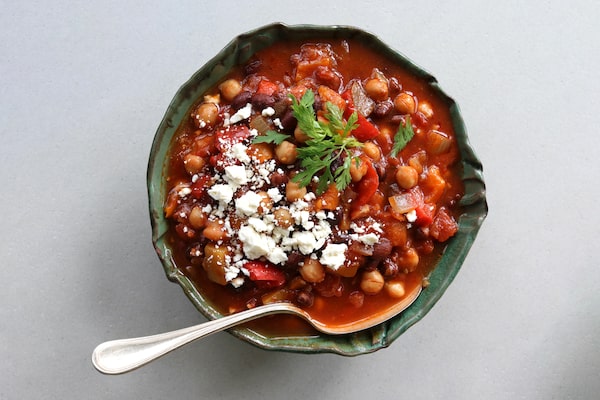
Making a pot of vegetarian chili is a great way to use up veggies in your fridge.Julie Van Rosendaal/The Globe and Mail
It has been well-established that more than a third of human-caused greenhouse-gas emissions are linked to the global food system, primarily agriculture and land use: methane emissions from the digestive process of cattle, nitrous oxide from fertilizers and the destruction of forest for farmland. Our food system uses 70 per cent of the world’s freshwater and is responsible for 80 per cent of freshwater pollution. And then there’s transport and refrigeration to consider, and the materials and industrial processes required not only for much of our food, but its packaging.
An extensive study published in the journal Nature Food in 2023 found than when compared with diets in which more than 100 grams of meat was consumed a day, vegan diets had a markedly reduced impact – around 75 per cent – on climate-heating emissions, water pollution and land use. Vegan diets also reduced wildlife destruction by 66 per cent and water use by 54 per cent.
How we prepare our food can also have an impact on the environment – and on our utility bills.
Fortunately, there are easy ways to reduce energy use on that front. You can tuck whole potatoes or winter squash into the oven to cook alongside your banana bread or lasagna as it bakes, for example. And slow cookers typically use less energy than an oven or stovetop, as do air fryers (really just small convection ovens), which are ideal for baking smaller quantities.
Or try thermal cooking, which works by holding on to residual heat to slow-cook dishes such as soups, stews and curries. You can buy thermal cookers, which are essentially pot-shaped vacuum flasks. Food is boiled on the stovetop in a removable insert that is then returned to its insulating shell to slow-cook over several hours without the need for power. Commercial versions, which tend to cost $100 or more, typically have basket-style handles and are ideal for day trips and camping: Bring your meal to a boil at home, pack it to go and open a hot, perfectly cooked lunch wherever you wind up.
You can also create a hot box at home that has the same effect. Tuck a bowl or old blanket into a cooler or other insulated container (or even just a solid wood box or plastic bin), creating a nest for a pot of food you’ve brought to a boil on the stovetop. Cover it with a tight lid, settle it in and tuck another blanket, towel or any material you have on hand around it to trap residual heat. Close the cooler or box and resist opening it up to check (which allows heat to escape) for about four hours.
Really Good Veggie Chili
A pot of chili can use up virtually any produce: wrinkly peppers, wilting cilantro or those tomatoes you tossed into the freezer whole (yes!) when they started going squishy. It’s delicious with cauliflower, zucchini, corn – whatever you like – and can be cooked on the stovetop or low and slow utilizing residual heat in a store-bought or homemade insulated cooker.
- canola oil
- 1 onion, chopped
- 2 red, yellow or orange peppers, seeded and chopped
- 1 jalapeno pepper, seeded and minced
- Salt, to taste
- 2 garlic cloves, crushed
- 1/2 bunch cilantro, chopped
- 1 tablespoon chili powder
- 2 teaspoons cumin
- 1 medium sweet potato, peeled and cut into chunks (or peeled and diced butternut squash)
- 1 28-ounce (796-ml) can diced, stewed or whole tomatoes (or a few tomatoes from your freezer, tossed in whole and then mashed in the pot, or grated)
- 2 19-ounce (540-ml) cans beans, such as kidney, black, pinto or chickpeas (or 3 to 4 cups cooked beans)
- crumbled feta or grated cheddar and extra cilantro, for serving (optional)
Set a pot or Dutch oven (cast iron is ideal if you want to use thermal heat to continue cooking) over medium-high heat, add a drizzle of oil and sauté the onion, peppers and jalapeno for about five minutes, sprinkling with salt, until soft. Add the garlic, cilantro (I chop and add the stems to the pot, and save the leaves for scattering on top), chili powder and cumin and cook for another minute or two.
Add the remaining ingredients and bring to a boil, stirring occasionally. Use one of the empty cans to add some water if it seems too thick. To continue to cook using residual heat, cover the pot with a tight lid and place on a towel in a cooler or other box. Tuck another towel (or old blanket, sweater or other material) around it and close the box. Leave to slow-cook with its residual heat for about four hours. Otherwise, continue to cook on the stovetop for 30 to 45 minutes, until the potato is tender and the sauce has thickened. Serve topped with crumbled feta or grated cheddar and extra cilantro, if you like.
Serves about six.